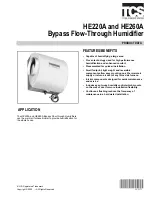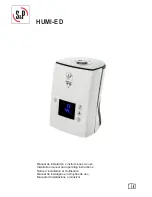
6. Install the replacement compressor with a new capacitor and an oversized liquid line flter.
In a running burn out, install an oversized suction line flter/drier between the accumulator and compressor.
Thoroughly fush the accumulator with refrigerant to remove all trapped sludge and to prevent the oil hole from
becoming plugged. A standing burn out does not require a suction line flter/drier.
7. Evacuate the system with a good vacuum pump and accurate vacuum gauge. Leave the pump on the system for at
least an hour.
8. Operate the system for a short period of time, monitoring the suction pressure to determine that the suction flter
is not becoming plugged. Replace the suction flter/drier if pressure drop occurs. If a severe running burn out has
occurred, several flter/driers may have to be replaced to remove all of the acid and moisture.
NOTE: NEVER use the compressor to evacuate the system or any part of it.
7.6C Replacing a Compressor, Non burn Out
Remove the refrigerant from the system. Replace the compressor and liquid line flter/drier. Charge the system to 50
PSIG and check for leaks. Remove the charge and weigh in the refrigerant quantity listed on the nameplate. Operate the
system to verify performance.
7.7 Remote Controls
The Quest 335 Dehumidifer is controlled by devices mounted on a panel that is remote from the unit. You may or may
not have the devices listed below depending on the model of the remote hygrostat you purchased. If the Quest 335
Dehumidifer fails to operate as desired, always check the settings of the controls to insure that they are correct. Check
that the controls are receiving 24VAC from the Quest 335 Dehumidifer. Check the connections between the Quest
335 Dehumidifer, the hygrostat, and the feld control wiring.
7.7A Humidity Control
The humidity control is an adjustable switch that closes when the relative humidity of the air in which it is located rises to
the set point. It opens when the RH drops 4 to 6% below the set point. If the Quest 335 Dehumidifer does not run, try
turning the humidity control Down using arrow on control pad. If it then runs, the humidity control is out of calibration or
the RH is below setpoint.
The Quest 335 Dehumidifer is equipped with an automatic defrost mechanism. If the Quest 335 Dehumidifer
operates in conditions that develop frost on the evaporator, it will sense the frost build-up and automatically defrost the
evaporator. The Quest 335 Dehumidifer may not appear to be operating correctly during the defrost sequence, but
once the defrost sequence is completed, the Quest 335 Dehumidifer will resume dehumidifying.
7.8 Defrost Thermostat
The defrost thermostat is attached to the refrigerant suction tube between the accumulator and the compressor. It will
automatically shut the compressor of if the low side refrigerant temperature drops due to excessive frost formation on
the evaporator coil. The impeller fan will continue to run, causing air to fow through the evaporator coil and melt the ice.
When the ice has melted, the evaporator temperature will rise and the thermostat will restart the compressor.
7.9 Condensate Pump Kit
An optional condensate pump kit is available from the factory for use with the Quest 335 Dehumidifer. Condensate is
automatically pumped to a remote location when the water level in the pump's reservoir rises to close the foat switch.
The pump also contains a safety foat switch. The white leads from this switch extend from beneath the pump cover. This
switch should be installed in series with the feld wire that connects the 24V from the Quest 335 Dehumidifer to the
hygrostat.
19






































